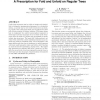Free Online Productivity Tools
i2Speak
i2Symbol
i2OCR
iTex2Img
iWeb2Print
iWeb2Shot
i2Type
iPdf2Split
iPdf2Merge
i2Bopomofo
i2Arabic
i2Style
i2Image
i2PDF
iLatex2Rtf
Sci2ools
PPDP
2001
Springer
2001
Springer
Cycle Therapy: A Prescription for Fold and Unfold on Regular Trees
Cyclic data structures can be tricky to create and manipulate in declarative programming languages. In a declarative setting, a natural way to view cyclic structures is as denoting regular trees, those trees which may be infinite but have only a finite number of distinct subtrees. This paper shows how to implement the unfold (anamorphism) operator in both eager and lazy languages so as to create cyclic structures when the result is a regular tree as opposed to merely infinite lazy structures. The usual fold (catamorphism) operator when used with a strict combining function on any infinite tree yields an undefined result. As an alternative, this paper defines and show how to implement a cycfold operator with more useful semantics when used with a strict function on cyclic structures representing regular trees. This paper also introduces an abstract data type (cycamores) to simplify the use of cyclic structures representing regular trees in both eager and lazy languages. Implement...
| Added | 30 Jul 2010 |
| Updated | 30 Jul 2010 |
| Type | Conference |
| Year | 2001 |
| Where | PPDP |
| Authors | Franklyn A. Turbak, J. B. Wells |
Comments (0)

